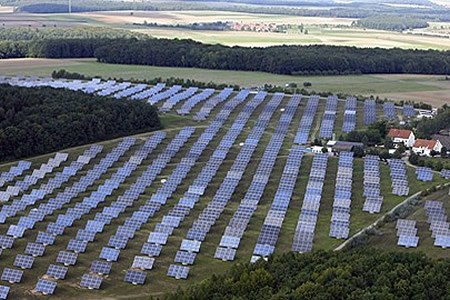Northwestern Ontario is proving to be favourable ground for renewable energy developers to scope out property.
The City of Dryden is entertaining serious bids from three solar companies, including two Canadian firms, each proposing a 10-megawatt (MW) project for the community.
Dryden is in an area with the second highest solar concentration in Canada and the third highest in North America.
The solar regime is even better than Germany, where one of the proponents is from.
"We didn't hunt them down, they hunted us down," says Vicki Kurz, Dryden's economic development officer.
There's three potential sites within the city boundaries.
The best spot is in the north end near the cemetery where there's about 200 acres of public and privately-owned land that's largely open and gently sloping to the south. It's ideal for both fixed and dual axis solar panels.
Kurz says this preferred site already has Ontario Hydro's approval.
The kind of dollars being talked about for the individual photovoltaic projects range between $40 to $60 million. If all three go off, it could mean a combined investment of $140 million to $170 million spent on equipment and employment. This is good news for the city particularly with taxation opportunities.
All three firms tell the city their proposals conceivably could be operational within a year or two if all the necessary approvals were in place.
Kurz says there's offers from other developers bidding on the north end site that could come forward by a mid-June deadline.
"We've held conference calls with several different firms...explained the projects and sent them maps on our properties..."
For now, the city is keeping its options open in choosing a land-lease route or getting into a municipally-owned solar project. Either way it stands to be a money-maker for the city.
The power generated could be sold into the Ontario grid or used within the city.
Kurz says there's still information forthcoming from Hydro One on the location and capacity of transmission lines and regional pinch-points which will likely influence the development corporation's final recommendations to city council.
"If we do an ownership agreement (with the developers) that might be a completely different thing if we're using (the power) for our own purposes."
A city energy committee will review all the final offers and could select a preferred site developer by late June.
Under the Ontario Power Authority's rules, individual developers are limited to 10 megawatts per transformer station and a maximum of 50 MW province-wide. In Dryden, there's one transformer capable of handling up to 30 MW of production.
Promoting the city of 8,200 as a 'green community' intent on economically diversifying itself beyond pulp and paper is the mandate of the new Dryden Development Corporation (DDC).
Kurz says there's potential for more opportunity in new mineral exploration and in the emerging agro-food sector. The DDC is also very keen on pursuing a strategy of nurturing local entrepreneurs through small business support, training and labour force development. The hub of that conceivably could be located in a proposed 30-acre commercial business park north of Highway 17.
A successful entrepreneurship workshop held last fall entitled FI:RE (Fueling Innovation: Reigniting Entrepreneurship) will be repeated again in early October.
"The whole theme is to connect people with resources and the ideas," says Kurz.
At the waterfront, Wabigoon Lake has always been a popular place for boaters, sport fishermen and wind surfers.
Now the city wants to enrich that quality of life experience with a sustainable waterfront development plan.
Though still conceptual, Van Horne Landing would feature a recreational mixed-use development of new marina slips, an eco-lodge, a restaurant, spa, specialty shops and an arts and interpretive centre.
The city is looking at acquiring 22 acres of a former Ministry of Natural Resources float plane base and a conservation area from the Ontario Realty Corp to tack onto a 10-acre municipal property.
There's funding applications into FedNor and Northern Ontario Heritage Fund to develop a business plan. Some British Columbia and local investors have shown some interest in the concept.
"The plan is to be the first rural sustainable development created in Canada," says Kurz.
On the tourism side, the Dryden Marketing Association is rolling out the area's first-ever comprehensive strategy by pulling together city officials and the hospitality sector. Outdoor recreational sports have traditionally been popular tourism pursuits.
"We know we have the hook-and-bullet advertising, but we want to promote Dryden as a business centre," says market development officer Vicki Blanchard who will organize conferences and small events into its high tech Regional Training and Cultural Centre.
There's granting dollars available to grow local festivals and to help local companies with marketing visuals to promote Dryden outside the region.
The new area tourism strategy comes with a new leisure guide and advertising outside community to entice people to come and stay.
While the early tourism booking numbers in the Northwest look bleak this year, Blanchard says the key is building relationships with resort owners, outfitters, hotel operators, and even other communities to expand vacation packages and appeal to niche travellers, like Europeans.
"What's good for Vermillion Bay and Kenora is good for us as long as we're working together to link those tourism opportunities."




